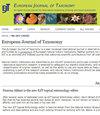以摩洛哥为重点修订西北非洲的 Andrena 动物群(膜翅目: Andrenidae)
IF 1.3
3区 生物学
Q3 ENTOMOLOGY
引用次数: 0
摘要
非洲西北部有一个庞大的安德里纳动物群,但对该国沿海地区以外的部分地区的研究仍然很少,而且由于研究历史悠久,加上模式标本检查不完善,对某些分类群的身份一直存在混淆。新的野外工作、基因条形码以及对博物馆材料的研究大大提高了我们对这一地区的了解。本文描述了 11 个新种:A. (Aciandrena) bendai sp、和 A. (incertae sedis)muelleri sp.Andrena (Aciandrena) nitidilabris Pérez, 1895 was misdiagnosed, and is actually the senior synonym of A. (Graecandrena) montarca parva Warncke, 1974 syn.Andrena (Aciandrena) pisantyi sp. nov.描述自阿尔及利亚、突尼斯和以色列,符合 A. nitidilabris auctorum sensu Warncke。和 A. (Micrandrena) heliaca Warncke, 1974 stat.Lectotypes are designated for A. (Melanapis) ephippium Spinola, 1838, A. (Melanapis) rutila Spinola, 1838, A. (Simandrena) rhypara Pérez, 1903, and A. (Suandrena) savignyi Spinola, 1838.Neotypes are designated for A. (Melandrena) soror Dours, 1872 and A. (Notandrena) nigroviridula Dours, 1873.(Aciandrena) triangulivalvis Wood, 2020 的雌性。报告了以下 7 个新的异名(高级名在前)A. (Chrysandrena) testaceipes Saunders, 1908 = A. (Chrysandrena) rubricorpora Wood, 2021 syn、A. (Lepidandrena) tuberculifera Pérez, 1895 = A. (Poecilandrena) nigriclypeus Wood, 2020 syn、(Notandrena) albohirta Saunders, 1908 = A. (Notandrena) eddaensis Gusenleitner, 1998 syn、(Taeniandrena) poupillieri Dours, 1872 = A. (Taeniandrena) lecerfi Benoist, 1961 syn.nigroviridula 的同义关系。与 2020 年基线相比,摩洛哥新记录了 16 个 Andrena 物种,并从动物清单中删除了 6 个物种。这些修订使摩洛哥已知的 Andrena 种类总数达到 202 种,其中有 25 种特有种,使摩洛哥成为全球 Andrena 多样性的热点地区之一。本文章由计算机程序翻译,如有差异,请以英文原文为准。
Revisions to the Andrena fauna of north-western Africa with a focus on Morocco (Hymenoptera: Andrenidae)
North-western Africa has a large Andrena fauna, but parts of the country away from coastal areas remain poorly studied, and confusion persists as to the identity of certain taxa due to the long history of study combined with imperfectly examined type material. New fieldwork, genetic barcoding, and study of museum material has substantially improved our understanding of this region. Eleven new species are described: A. (Aciandrena) bendai sp. nov., A. (Aciandrena) ifranensis sp. nov., A. (Euandrena) berberica sp. nov., A. (Hoplandrena) darha sp. nov., A. (Micrandrena) anammas sp. nov., A. (Micrandrena) gemina sp. nov., A. (Micrandrena) tinctoria sp. nov., and A. (incertae sedis) muelleri sp. nov., all from Morocco, and A. (Aciandrena) quieta sp. nov., A. (Euandrena) abscondita sp. nov., and A. (Taeniandrena) prazi sp. nov. from Morocco and Tunisia. Andrena (Aciandrena) nitidilabris Pérez, 1895 was misdiagnosed, and is actually the senior synonym of A. (Graecandrena) montarca parva Warncke, 1974 syn. nov. Andrena (Aciandrena) pisantyi sp. nov. is described from Algeria, Tunisia, and Israel, conforming to A. nitidilabris auctorum sensu Warncke. Andrena (Graecandrena) andina Warncke, 1974 stat. nov. and A. (Micrandrena) heliaca Warncke, 1974 stat. nov. are elevated from sub species to species status. Lectotypes are designated for A. (Melanapis) ephippium Spinola, 1838, A. (Melanapis) rutila Spinola, 1838, A. (Simandrena) rhypara Pérez, 1903, and A. (Suandrena) savignyi Spinola, 1838. Neotypes are designated for A. (Melandrena) soror Dours, 1872 and A. (Notandrena) nigroviridula Dours, 1873. The female of A. (Aciandrena) triangulivalvis Wood, 2020 is described. The following seven additional synonymies are reported (senior name first): A. (Chrysandrena) testaceipes Saunders, 1908 = A. (Chrysandrena) rubricorpora Wood, 2021 syn. nov., A. (incertae sedis) maidaqi Scheuchl & Gusenleitner, 2007 = A. (Carandrena) hoggara Wood, 2021 syn. nov., A. (Lepidandrena) tuberculifera Pérez, 1895 = A. (Poecilandrena) nigriclypeus Wood, 2020 syn. nov., A. (Notandrena) albohirta Saunders, 1908 = A. (Notandrena) eddaensis Gusenleitner, 1998 syn. nov., A. (Notandrena) microthorax Pérez, 1895 = A. (Notandrena) nigrocyanea Saunders, 1908 syn. nov., A. (Simandrena) rhypara = A. (Simandrena) palumba Warncke, 1974 syn. nov., and A. (Taeniandrena) poupillieri Dours, 1872 = A. (Taeniandrena) lecerfi Benoist, 1961 syn. nov. Andrena (Notandrena) viridiaenea Pérez, 1903 is returned to synonymy with A. nigroviridula. Relative to the 2020 baseline, 16 Andrena species are newly recorded for Morocco, and six species are removed from the faunal list. These revisions bring the total number of Andrena species known from Morocco to 202 with 25 endemic species, making it one of the hotspots for Andrena diversity globally.
求助全文
通过发布文献求助,成功后即可免费获取论文全文。
去求助
来源期刊

European journal of taxonomy
ZOOLOGY-
CiteScore
2.30
自引率
8.30%
发文量
173
审稿时长
29 weeks
期刊介绍:
EJT is a fully refereed, international, fully electronic Open Access journal in descriptive taxonomy, covering subjects in zoology, entomology, botany (in its broadest sense), and palaeontology. EJT-papers must be original and adhere to high scientific (content) and technical (language, artwork, etc.) standards. Manuscripts that are clearly substandard in either of these categories will not be sent out for review. EJT is supported by a consortium of European Natural History Institutes, but its scope is global. Both authorship and geographical region of study need not be European. Authors are, however, strongly encouraged to involve European Natural History collections by consulting material or by depositing specimens (e.g. types and figured material) related to their published paper in the collection of a European Natural History Institute.
 求助内容:
求助内容: 应助结果提醒方式:
应助结果提醒方式:


